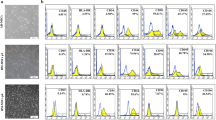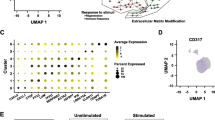Abstract
Glutamine (GLUT) is a nonessential amino acid that can become conditionally essential under stress conditions, being able to act in the modulation of the immune responses. Mesenchymal stem cells (MSCs) are known to their capability in the modulation of immune responses through cell-cell contact and by the secretion of soluble factors. Considering that GLUT is an immunonutrient and little is known about the influence of GLUT on the capability of MSCs to modulate immune cells, this work aims to investigate how variations in GLUT concentrations in vitro could affect some immunomodulatory properties of MSCs. In order to evaluate the effects of GLUT on MSCs immunomodulatory properties, cell proliferation rates, the expression of NFκB and STAT-3, and the production of IL-1β, IL-6, IL-10, TGF-β and TNF-α by MSCs were assessed. Based on our findings, GLUT at high doses (10 mM) augmented the proliferation of MSCs and modulated immune responses by decreasing levels of pro-inflammatory cytokines, such as IL-1β and IL-6, and by increasing levels of anti-inflammatory cytokines IL-10 and TGF-β. In addition, MSCs cultured in higher GLUT concentrations (10 mM) expressed lower levels of NF-κB and higher levels of STAT-3. Furthermore, conditioned media from MSCs cultured at higher GLUT concentrations (10 mM) reduced lymphocyte and macrophage proliferation, increased IL-10 production by both cells types, and decreased IFN-γ production by lymphocytes. Overall, this study showed that 10 mM of GLUT is able to modify immunomodulatory properties of MSCs.





Similar content being viewed by others
References
Newsholme, P. (2001). Why is L-glutamine metabolism important to cells of the immune system in health, postinjury, surgery or infection? Journal of Nutrition, 131(9), 2515S–2522S.
Tapiero, H., Mathé, G., Couvreur, P., Tew, K.D. (2002). II. Glutamine and glutamate. Biomedicine & Pharmacotherapy, 56(9), 446–457.
Matés, J. M., Segura, J. A., Martín-Rufián, M., Campos-Sandoval, J. A., Alonso, F. J., & Márquez, J. (2013). Glutaminase isoenzymes as key regulators in metabolic and oxidative stress against cancer. Current Molecular Medicine, 13(4), 514–534.
Brasse-Lagnel, C. G., Lavoinne, A. M., & Husson, A. S. (2010). Amino acid regulation of mammalian gene expression in the intestine. Biochimie, 92(7), 729–735.
Hakvoort, T. B., He, Y., Kulik, W., et al. (2017). Pivotal role of glutamine synthetase in ammonia detoxification. Hepatology, 65(1), 281–293.
Zhang, B., Lin, M., Yu, C., et al. (2016). Alanyl-glutamine supplementation regulates mTOR and ubiquitin proteasome proteolysis signaling pathways in piglets. Nutrition, 32(10), 1123–1131.
Calder, P. C., & Yaqoob, P. (1999). Glutamine and the immune system. Amino Acids, 17(3), 227–241.
Holecek, M. (2013). Side effects of long-term glutamine supplementation. Journal of Parenteral and Enteral Nutrition, 37(5), 607–616.
Kim, H. (2011). Glutamine as an immunonutrient. Yonsei Medical Journal, 52(6), 892–897.
Ito, K., & Suda, T. (2014). Metabolic requirements for the maintenance of self-renewing stem cells. Nature Reviews Molecular Cell Biology, 15(4), 243–256.
Friedenstein, A. J., Gorskaja, J. F., & Kulagina, N. N. (1976). Fibroblast precursors in normal and irradiated mouse hematopoietic organs. Experimental Hematology, 4(5), 267–274.
Caplan, A. (2005). Review: Mesenchymal stem cells: Cell-based reconstructive therapy in orthopedics. Tissue Engineering, 11(7–8), 1198–1211.
García-García, A., de Castillejo, C. L., & Méndez-Ferrer, S. (2015). BMSCs and hematopoiesis. Immunology Letters, 168(2), 129–135.
Bernardo, M. E., & Fibbe, W. E. (2015). Mesenchymal stromal cells and hematopoietic stem cell transplantation. Immunology Letters, 168(2), 215–221.
Zhang, J., Huang, X., Wang, H., et al. (2015). The challenges and promises of allogeneic mesenchymal stem cells for use as a cell-based therapy. Stem Cell Research & Therapy, 1(6), 234.
Lee, M. W., Ryu, S., Kim, D. S., Sung, K. W., Koo, H. H., & Yoo, K. H. (2015). Strategies to improve the immunosuppressive properties of human mesenchymal stem cells. Stem Cell Research & Therapy, 7(6), 179.
Dos Santos, G. G., Batool, S., Hastreiter, A., et al. (2016). The influence of protein malnutrition on biological and immunomodulatory aspects of bone marrow mesenchymal stem cells. Clinical Nutrition, S0261-5614(16), 30202–30203.
Eagle, H., Oyama, V. I., Levy, M., Horton, C. L., & Fleischman, R. (1956). The growth response of mammalian cells in tissue culture to L-glutamine and L-glutamic acid. Journal of Biological Chemistry, 218, 607–616.
Wischmeyer, P. E., Riehm, J., Singleton, K. D., et al. (2003). Glutamine attenuates tumor necrosis factor-alpha release and enhances heat shock protein 72 in human peripheral blood mononuclear cells. Nutrition, 19, 1–6.
Chandra, R. K. (1987). Nutrition and immunity: Practical applications of Research findings. Canadian Family Physician, 33, 1417–1420.
Higuera, G. A., Schop, D., Spitters, T. W., et al. (2012). Patterns of amino acid metabolism by proliferating human mesenchymal stem cells. Tissue Engineering Part a, 18(5–6), 654–664.
Schop, D., Janssen, F. W., Borgart, E., de Bruijn, J. D., & van Dijkhuizen-Radersma, R. (2008). Expansion of mesenchymal stem cells using a microcarrier-based cultivation system: Growth and metabolism. Journal of Tissue Engineering and Regenerative Medicine, 2(2–3), 126–135.
Grivennikov, S. I., & Karin, M. (2010). Dangerous liaisons: STAT3 and NF-kappaB collaboration and crosstalk in cancer. Cytokine & Growth Factor Reviews, 21(1), 11–19.
De Miguel, M. P., Fuentes-Julián, S., & Blázquez-Martínez, A. (2012). Immunosuppressive properties of mesenchymal stem cells: Advances and applications. Current Molecular Medicine, 12(5), 574–591.
Kyurkchiev, D., Bochev, I., Ivanova-Todorova, E., et al. (2014). Secretion of immunoregulatory cytokines by mesenchymal stem cells. World J Stem Cells, 6(5), 552–570.
Murray, P. J. (2005). The primary mechanism of the IL-10-regulated antiinflammatory response is to selectively inhibit transcription. Proceedings of the National Academy of Sciences of the United States of America, 102(24), 8686–8691.
Levy, D. E., & Lee, C. K. (2002). What does Stat3 do? Journal of Clinical Investigation, 109(9), 1143–1148.
Riley, J. K., Takeda, K., Akira, S., & Schreiber, R. D. (1999). Interleukin-10 receptor signaling through the JAK-STAT pathway. Requirement for two distinct receptor-derived signals for anti-inflammatory action. Journal of Biological Chemistry, 274(23), 16513–16521.
Bonecini-Almeida, M. G., Ho, J. L., Boechat, N., et al. (2004). Down-modulation of lung immune responses by interleukin-10 and transforming growth factor beta (TGF-beta) and analysis of TGF-beta receptors I and II in active tuberculosis. Infection and Immunity, 72(5), 2628–2634.
Ghannam, S., Bouffi, C., Djouad, F., Jorgensen, C., & Noël, D. (2010). Immunosuppression by mesenchymal stem cells: Mechanisms and clinical applications. Stem Cell Research & Therapy, 1(1), 2.
Glennie, S., Soeiro, I., Dyson, P. J., Lam, E. W., & Dazzi, F. (2005). Bone marrow mesenchymal stem cells induce division arrest anergy of activated T cells. Blood, 105(7), 2821–2827.
Groux, H., & Cottrez, F. (2003). The complex role of interleukin-10 in autoimmunity. Journal of Autoimmunity, 20(4), 281–285.
Scapini, P., Lamagna, C., Hu, Y., et al. (2011). B cell-derived IL-10 suppresses inflammatory disease in Lyn-deficient mice. Proceedings of the National Academy of Sciences of the United States of America, 108(41), E823–E832.
Sabat, R., Grutz, G., Warszawska, K., et al. (2010). Biology of interleukin-10. Cytokine & Growth Factor Reviews, 21(5), 331–344.
Di Nicola, M., Carlo-Stella, C., Magni, M., et al. (2002). Human bone marrow stromal cells suppress T-lymphocyte proliferation induced by cellular or nonspecific mitogenic stimuli. Blood, 99(10), 3838–3843.
Aggarwal, S., & Pittenger, M. F. (2005). Human mesenchymal stem cells modulate allogeneic immune cell responses. Blood, 105(4), 1815–1822.
Sun, L., Akiyama, K., Zhang, H., et al. (2009). Mesenchymal stem cell transplantation reverses multiorgan dysfunction in systemic lupus erythematosus mice and humans. Stem Cells, 27(6), 1421–1432.
Najar, M., Rouas, R., & Raicevic, G. (2009). Mesenchymal stromal cells promote or suppress the proliferation of T lymphocytes from cord blood and peripheral blood: The importance of low cell ratio and role of interleukin-6. Cytotherapy, 11(5), 570–583.
Liu, X. J., Zhang, J. F., & Sun, B. (2009). Reciprocal effect of mesenchymal stem cell on experimental autoimmune encephalomyelitis is mediated by transforming growth factor-beta and interleukin-6. Clinical & Experimental Immunology, 158(1), 37–44.
Steinman, R. M., & Banchereau, J. (2007). Taking dendritic cells into medicine. Nature, 449(7161), 419–426.
Maggini, J., Mirkin, G., Bognanni, I., et al. (2010). Mouse bone marrow-derived mesenchymal stromal cells turn activated macrophages into a regulatory-like profile. PloS One, 5, e9252.
Zhang, Q. Z., Su, W. R., Shi, S. H., et al. (2010). Human gingiva-derived mesenchymal stem cells elicit polarization of m2 macrophages and enhance cutaneous wound healing. Stem Cells, 28(10), 1856–1868.
O'Garra, A., & Murphy, K. M. (2009). From IL-10 to IL-12: How pathogens and their products stimulate APCs to induce T(H)1 development. Nature Immunology, 10(9), 929–932.
Acknowledgements
The authors thank FAPESP for financial support. Fock RA and Borelli P are fellows of the Conselho Nacional de Pesquisa e Tecnologia (CNPq).
Author information
Authors and Affiliations
Corresponding author
Ethics declarations
Conflict of Interest
The authors declare no potential conflicts of interest.
Rights and permissions
About this article
Cite this article
dos Santos, G.G., Hastreiter, A.A., Sartori, T. et al. L-Glutamine in vitro Modulates some Immunomodulatory Properties of Bone Marrow Mesenchymal Stem Cells. Stem Cell Rev and Rep 13, 482–490 (2017). https://doi.org/10.1007/s12015-017-9746-0
Published:
Issue Date:
DOI: https://doi.org/10.1007/s12015-017-9746-0




